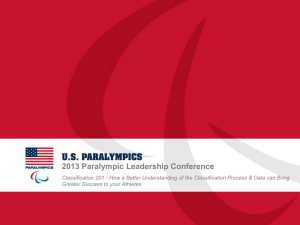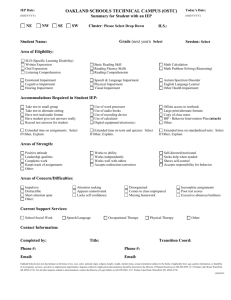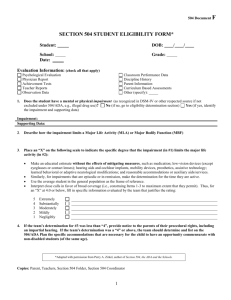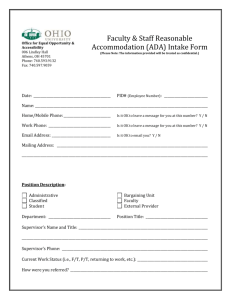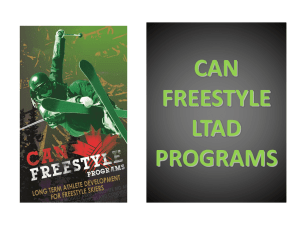Classification in Para-Sport
advertisement
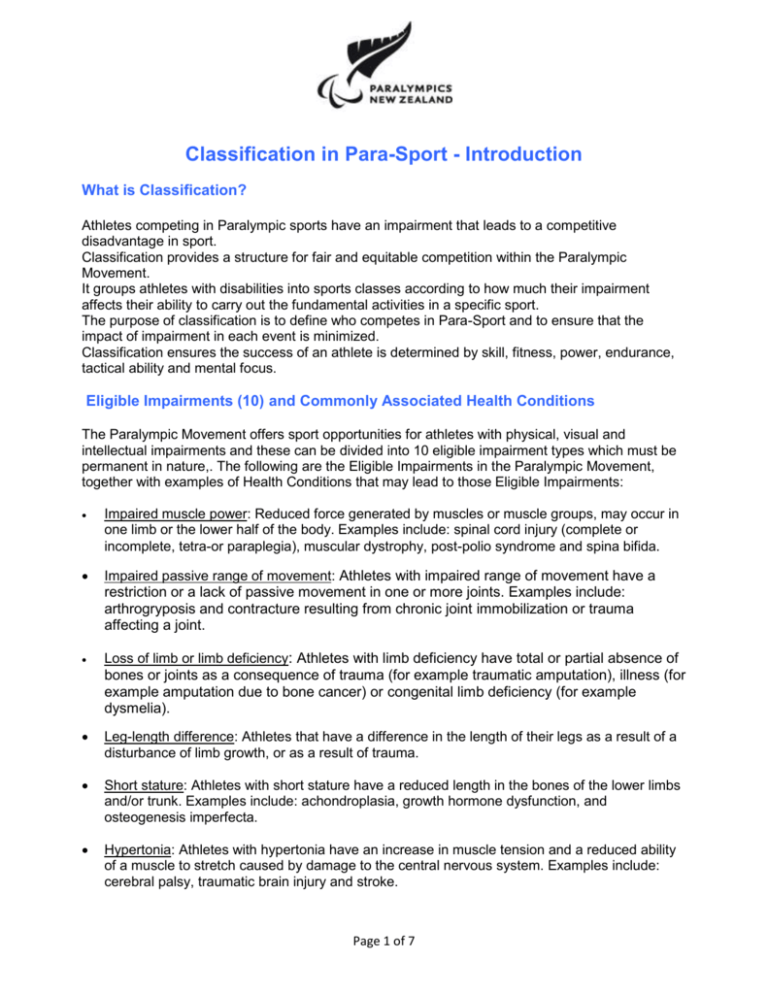
Classification in Para-Sport - Introduction What is Classification? Athletes competing in Paralympic sports have an impairment that leads to a competitive disadvantage in sport. Classification provides a structure for fair and equitable competition within the Paralympic Movement. It groups athletes with disabilities into sports classes according to how much their impairment affects their ability to carry out the fundamental activities in a specific sport. The purpose of classification is to define who competes in Para-Sport and to ensure that the impact of impairment in each event is minimized. Classification ensures the success of an athlete is determined by skill, fitness, power, endurance, tactical ability and mental focus. Eligible Impairments (10) and Commonly Associated Health Conditions The Paralympic Movement offers sport opportunities for athletes with physical, visual and intellectual impairments and these can be divided into 10 eligible impairment types which must be permanent in nature,. The following are the Eligible Impairments in the Paralympic Movement, together with examples of Health Conditions that may lead to those Eligible Impairments: Impaired muscle power: Reduced force generated by muscles or muscle groups, may occur in one limb or the lower half of the body. Examples include: spinal cord injury (complete or incomplete, tetra-or paraplegia), muscular dystrophy, post-polio syndrome and spina bifida. Impaired passive range of movement: Athletes with impaired range of movement have a restriction or a lack of passive movement in one or more joints. Examples include: arthrogryposis and contracture resulting from chronic joint immobilization or trauma affecting a joint. Loss of limb or limb deficiency: Athletes with limb deficiency have total or partial absence of bones or joints as a consequence of trauma (for example traumatic amputation), illness (for example amputation due to bone cancer) or congenital limb deficiency (for example dysmelia). Leg-length difference: Athletes that have a difference in the length of their legs as a result of a disturbance of limb growth, or as a result of trauma. Short stature: Athletes with short stature have a reduced length in the bones of the lower limbs and/or trunk. Examples include: achondroplasia, growth hormone dysfunction, and osteogenesis imperfecta. Hypertonia: Athletes with hypertonia have an increase in muscle tension and a reduced ability of a muscle to stretch caused by damage to the central nervous system. Examples include: cerebral palsy, traumatic brain injury and stroke. Page 1 of 7 Ataxia: Athletes with ataxia have uncoordinated movements caused by damage to the central nervous system. Examples include: cerebral palsy, traumatic brain injury, stroke and multiple sclerosis. Athetosis: Athletes with athetosis have continual slow involuntary movements. Examples include cerebral palsy, traumatic brain injury and stroke Visual impairment: Athletes with impaired vision have reduced or no vision caused by damage to the eye structure, optical nerves or optical pathways, or visual cortex of the brain. Examples include: retinitis pigmentosa and diabetic retinopathy Intellectual Impairment: Athletes with an intellectual Impairment have a restriction in intellectual functioning and adaptive behavior in which affects conceptual, social and practical adaptive skills required for everyday life. This Impairment must be present before the age of 18. The presence of a permanent eligible impairment must be proven by means of medical diagnostic information that must be presented no later than at the time of athlete evaluation. Non-Eligible Impairments Any Impairment not listed in above is referred to as a non-eligible Impairment. Examples include: Pain Hearing impairment Low muscle tone Hypermobility of joints Joint instability, such as unstable shoulder joint, recurrent dislocation of a joint Impaired muscle endurance Impaired motor reflex functions Impaired cardiovascular function Impaired respiratory functions Impairment metabolic functions Tics and mannerisms, stereotypes and motor perseveration Health Conditions that will not lead to an Eligible Impairment International Sport Federations may specify in their Classification Rules that certain Health Conditions do not lead to an Eligible Impairment. Any Athlete who is only affected by such Health Condition will not be considered for Classification in relation to one or more sports governed by that International Sport Federation. The IPC has specified certain Health Conditions that do not lead to an Eligible Impairment. Examples are: Health conditions that primarily cause pain, such as myofacial pain-dysfunction syndrome, fibromyalgia or complex regional pain syndrome. Health Conditions that primarily cause fatigue, such as chronic fatigue syndrome. International Standard for Eligible Impairments 7 Health Conditions that primarily cause joint hypermobility or hypotonia, such as Ehlers-Danlos syndrome Health Conditions which are primarily psychological or psychosomatic in nature, such as conversion disorders or post-traumatic stress disorder. Page 2 of 7 Classification Systems Classification systems differ by sport and are developed by the International Federations (IF) governing the sport. The IF is also responsible to review the system from time to time. IFs decide which eligible impairment types their sport will cater to. Some Paralympic sports are only designed for athletes with one eligible impairment type. Goalball, for example, is only open to athletes with visual impairment. Other sports, such as athletics and swimming, are open to athletes with any of the 10 eligible impairments recognized by IPC. IFs also decide how severe impairment must be in order for an athlete to be eligible to compete in their sport. For an athlete to be eligible the impairment must be severe enough that it impacts his or her sport performance. This is called the ‘Minimum Impairment Criterion’. If an athlete fails to meet the Minimum Impairment Criterion, it does not question the presence of a genuine impairment; it is only a ruling on the eligibility of the athlete to compete in a particular sport under the IF Sport Rules. Since different sports require different abilities, each sport logically requires its own classification system. For example, an impairment of the arms affects performance in a running event in athletics to a lesser extent than it affects performance in swimming. The only exception to the sport-specific character of Paralympic classification is the classification for athletes with visual impairment. This system is still a medical system and the sport class allocated therefore applies across all sports (but the naming of the class may differ). Guide to Para-Sports and Impairment Inclusion Summer Para-Sports: ..\..\IPC Guide to Classification\150731131044465_2015_07_29+Explanatory+guide+Classification_summe r+FINAL+.pdf Winter Para-Sports: ..\..\IPC Guide to Classification\121203164523073_WinterSportLaymens.pdf Quick Guide to Sport and Impairment Eligibility Y:\Classification Information\Athlete Information 2015\Information for Athletes\Eligible Impairments.xlsx Sport Classes A sport class is a category which groups athletes depending on how much their impairment impacts performance in their sport. Therefore, a sport class is not necessarily comprised of one impairment type alone, but can be comprised of athletes with different impairments. However, these different impairments affect sport performance to a similar extent. For example, you will find athletes with paraplegia and double above-knee amputation competing in the same sport class in athletics because their different impairments have a comparable effect on their 1,500m wheelchair racing performance. Page 3 of 7 In individual sports, athletes compete against athletes in their own sport class to ensure the impact of impairment is minimized. In national events and smaller international competitions athletes in different sport classes may compete together for one medal, because there are not enough athletes for each sport class to create a competitive event. In these cases, athletes in different sport classes may be given a ‘coefficient’ or correction score to account for the different levels of activity limitation. Some Para-Sports only have only one sport class, such as powerlifting. To compete in these sports, the athletes only need to meet the minimum impairment criteria. In team sports, the players are allocated points, which indicate their activity limitation. A lower score indicates a more severe activity limitation than a higher score. A team is not allowed to have more than a certain maximum sum of points on the field of play at the same time in order to ensure equal competition with the opposing team. How is a Sport Class Allocated to an Athlete? A sport class is allocated through athlete evaluation by a group of classifiers. Each IF trains and certifies classifiers to conduct athlete evaluation in its sport. Classifiers assessing athletes with the various physical impairments listed above either have a medical background or are technical experts in their sport. Classifiers for athletes with a visual impairment have a background in ophthalmology or optometry. Psychologists and sport experts are responsible for the classification of athletes with an intellectual impairment. Athlete Evaluation takes place before competitions. Therefore, athletes who need to be classified arrive at the competition a few days early. Depending on the type and severity of the impairment an athlete might undergo athlete evaluation several times throughout his or her career. Some impairments change over time, e.g. visual acuity might decrease over time or hypertonia may increase. Also, junior athletes may not yet have reached skeletal maturity by the time of first classification (e.g. in swimming). In these cases, classifiers can decide that the athlete has to be seen again at the next competition or at set timeframes (e.g. (bi-) annual review). Athlete evaluation at a competition may encompass the following: An assessment of whether or not the Athlete has an Eligible Impairment for the relevant sport; An assessment of whether or not an Athlete complies with Minimum Impairment Criteria for the relevant sport; An assessment and evaluation of the extent to which the Athlete is able to execute the specific tasks and activities fundamental to the sport; If required, the conduct of Observation in Competition Assessment; The allocation of a Sport Class and designation of a Sport Class Status. Athletes have the right to challenge a decision taken by classification panels. The IPC Classification Code defines protest and appeal opportunities, which need to be adhered to by each sport. Page 4 of 7 When is Classification Conducted? There are three types of classifications: Provisional, National and International. Click on the link below for more information: ..\Paralympics New Zealand Classification Handbook\Provisional, National and International Classification.docx Provisional Classification Forms and Fact Sheets Physical Impairment: ..\Classification in Para-Sport - Forms\Physical Impairment\PI Provisional Classification Sheet - Para-Athletes with a Physical Impairment.docx ..\Classification in Para-Sport - Forms\Physical Impairment\Classification Fact Sheet Para-Athletes with Physical Impairment.docx Visual Impairment: ..\Classification in Para-Sport - Forms\Physical Impairment\PI Provisional Classification Sheet - Para-Athletes with a Physical Impairment.docx ..\Classification in Para-Sport - Forms\Visual Impairment\Classification Fact Sheet-ParaAthletes with Visual Impairment.docx Intellectual impairment: ..\Classification in Para-Sport - Forms\Intellectual Impairment\II Provisional Classification Form - Para-Athletes with Intellectual Impairment.docx ..\Classification in Para-Sport - Forms\Intellectual Impairment\Classification Fact Sheet Para-Athletes with Intellectual Impairment.docx Invictus Games: ..\Classification in Para-Sport - Forms\Invictus Games\Invictus Games Provisional Classification Form.docx Role of Paralympics New Zealand in Classification Paralympics New Classification Strategy: ..\..\..\..\Classification Programme Development\2015-2016\Classification Strategy and National Classification Programme\Final Document V.8\PARALYMPICS NEW ZEALAND CLASSIFICATION STRATEGY.pdf Classification Strategy Flow Chart: ..\..\..\..\Classification Programme Development\2015-2016\Classification Strategy and National Classification Programme\Final Document V.8\Copy of 2015_03 Org Chart PNZ v.3.docx National Classification Programme: ..\..\..\..\Classification Programme Development\2015-2016\Classification Strategy and National Classification Programme\Final Document V.8\NATIONAL CLASSIFICATION PROGRAMME.pdf Page 5 of 7 Paralympics New Zealand Handbook (Currently under review) ..\..\..\PNZ Classification Handbook\Final Copies\PNZ Classification Rules Regulations and Handbook Version 4- October 2012.pdf Commonly Asked Questions (To be developed) Media guide for Classification (To be developed) Event organizers Guide for Classification (To be developed) Classifiers Information (To be developed) Want to Learn More? If you would like to learn more about classification, please have a look at the following documents. IPC Classification Code This is the most important document governing the Paralympic Movement in regards to classification. It helps to support and co-ordinate the development and implementation of accurate, reliable and consistent sport focused classification systems. It was published in 2007 and is part of the IPC Handbook. Available at: www.paralympic.org/sites/default/files/document/120201084329386_2008_2_Classification_Code 6.pdf IPC Position Statement on Background and Scientific Rationale for Classification in Paralympic Sport This position statement, which was written by Sean Tweedy and Yves Van Landewijck, explains what evidence based classification means and how this can be achieved. It shows how classification systems should be based on scientific evidence. The IPC has officially committed to the aim of evidence based classification with the approval of this position statement by the Governing Board in 2009. Available at: www.paralympic.org/sites/default/files/document/120203171258165_Sec_ii_chapter_4.4_Position_ Statement_on_Classification.pdf Introduction to the Paralympic Movement If you want to learn more about the history of the Paralympic Movement and classification, from the beginnings in Stoke Mandeville to today’s London 2012 Paralympic Games, then the article “Introduction to the Paralympic Movement” by Sean Tweedy and P. David Howe can be highly recommended. The article is available in the following book: Y.C. Van Landewijck & W.R. Thompson (Eds.): The Paralympic Athlete. Wiley- Blackwell: IOC Handbook of Sports Medicine and Science. Page 6 of 7 IPC Website For news and videos about the Paralympic Movement, information about the IPC structure and classification, please visit the IPC website: www.paralympic.org. You may also find the section on Classification of the website interesting: www.paralympic.org/Classification/Introduction For further information on classification contact: Paralympics New Zealand 2.10 Axis Building 1 Cleveland Road, Parnell Auckland 1052 New Zealand 09 526 0760 classification@paralympics.org.nz www.paralympics.org.nz Page 7 of 7
